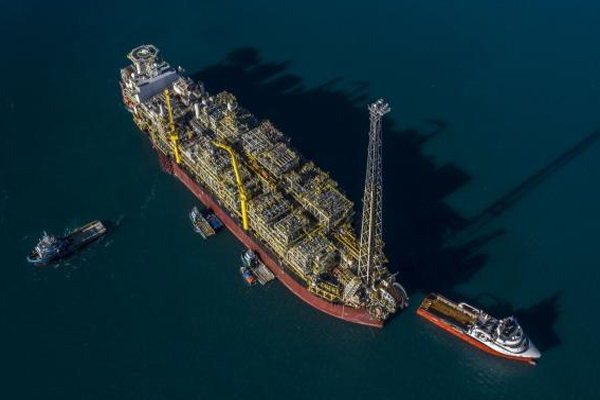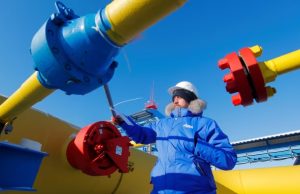Output across the region is set to barely budge this year.

anchored in Angra dos Reis, Rio de Janeiro state, Brazil, on Thursday, July 1, 2021.(dado Galdieri/Bloomberg)
Peter Millard, Bloomberg News
RIO
EnergiesNet.com 023 02 2022
The return of $100 oil and repercussions from Russia’s invasion of Ukraine have traders and investors wondering where the world can turn to for more supplies. For those looking to Latin America, think again.
The region is a historic commodities exporter, and in previous commodity price cycles it has responded with additional barrels. But this time, it’s ill-prepared to pump more, despite demand rebounding from Covid-19, low inventories and geopolitical upheaval as the war in Ukraine brings the possibility of sanctions that would limit the trade in crude from Russia, one the world’s biggest producers.
Another reason the oil market is so tight is years of under-investment in production. That partly helps explain why Latin America won’t be exporting a lot more crude anytime soon. Production growth has stabilized in Brazil, the region’s biggest producer, and it’s unlikely to start rebounding until new deep-water production vessels come online in 2023. Mexican output has been impacted by financial and operating problems at state-owned Petroleos Mexicanos, and other producers have been discouraged by the country’s return to resource nationalism under President Andres Manuel Lopez Obrador. Energy consultancy IPD Latin America expects Mexico to only grow about 40,000 barrels a day this year.“Most Latin American producers are at capacity at the moment,” said Todd Martinez, a senior director at Fitch Ratings who covers the region. “For now, the boom comes from the price.”This means any additional supplies will need to come from U.S. shale producers and the Organization of Petroleum Exporting Countries in a market where demand has returned to pre-Covid levels, but production has not. According to Rystad Energy, there is a 1.5 million barrel a day supply deficit globally that could rise to 2 million barrels a day by the summer in the Northern Hemisphere.
Colombian output declined to an 11-year low in 2020 and continued to fade last year due to a combination of the pandemic and protests in oil producing regions. The industry needs major investments, in shale or fresh discoveries offshore, to regain what was lost. Sanctioned Venezuela is the biggest question mark. Last year it increased oil production for the first time in seven years in a stunning rebound. Experts say the country can’t add much more without investing in drilling and equipment repairs.
Read: Venezuela’s Diminished Oil Industry Mounts an Unlikely RecoveryEcuador is posting the strongest windfall from higher oil prices because the commodity is a bigger share of its tax revenue than countries such as Mexico, Brazil and Colombia who pump more crude, according to Fitch. Still, the International Energy Agency is projecting stable output this year.The two countries with the most potential to expand, Brazil and Guyana, aren’t in a position like U.S. shale or onshore producers in the Middle East, where new wells can come on line in a matter of months. It takes years just to build the massive production tankers and then at least a year to connect all the wells in the open ocean.In Brazil, Petroleo Brasileiro SA’s contribution to state coffers nearly doubled in 2021 to 230 billion reais ($40 billion) thanks to higher oil prices. But this revenue boost isn’t trickling down to its business plan. The price surge won’t result in any short-term changes to Petrobras’s production targets or bring new projects into development, Joao Henrique Rittershaussen, its head of production development, said Thursday. “Brazil and Guyana, the only two places that had projected increased production, can’t respond with additional barrels” to short-term price increases, said Francisco Monaldi, a Venezuelan-American lecturer in energy economics at Rice University’s Baker Institute for Public Policy. “On top of this, you have to compete for inputs for things like rigs when prices go up.”
Read: Oil’s Spectacular Covid Crash Set the World Up for $100 Crude
Higher fuel prices are stoking inflation and frustrating consumers around the world and in the region. Energy costs have become a campaign issue in Brazil. Ecuador froze fuel prices late last year. Brent oil soared above $105 after Russia attacked targets across Ukraine.
While Latin America only pumps about 8% of the world’s oil, it’s regularly cited as a key source of incremental supplies outside of OPEC. Meanwhile, Russia pumped 11.3 million barrels of oil a day in January, according to IEA data. That’s a significant chunk of global demand that sits around 100 million barrels a day.Latin America’s main standout on production growth is Guyana, where Exxon Mobil Corp. is gradually increasing a 220,000 barrel a day offshore project. And even there, it isn’t expected to reach capacity until 2023, said Marcelo de Assis, the head of Latin American upstream research at consultant Wood Mackenzie Ltd. Any additional barrels in Brazil will mainly help compensate for declining output at legacy fields this year, he said. Suriname has made some exciting offshore discoveries, but none are expected to start producing before 2025.
The political landscape in Latin America contrasts sharply with the last time oil surpassed $100 a barrel in 2011. Brazil was just beginning to harness its biggest discoveries in a new deep-water region known as the pre-salt, while Mexico was opening up an exploration frontier in deep waters as well. Venezuela was pumping strong as a viable member of OPEC. Both populist and business-minded administrations were promising to bankroll social development with robust oil revenues.
In a region historically reliant on commodities, investing in oil was a winning slogan with voters who saw it as a path to social development and affordable energy. This decade, some countries are starting to see a shift toward greener policies that focus on renewables instead of fossil fuels.
“This time it’s different. People have to think about what eventually will happen with oil demand,” said Monaldi.
bloomberg.com 03 01 2022












